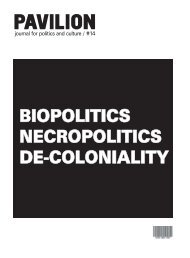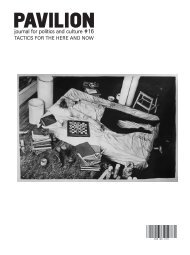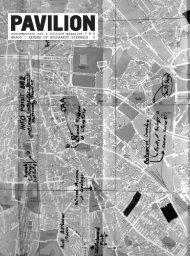PAVILION
PAVILION
PAVILION
- No tags were found...
Create successful ePaper yourself
Turn your PDF publications into a flip-book with our unique Google optimized e-Paper software.
including the politics embedded therein,<br />
demystifies the endgame that opposes<br />
the street to the control room. Far from<br />
harboring a ludic freedom diametrically<br />
opposed to the panopticism initiated by<br />
Haussmann, the street in all its iterations<br />
has become a privileged realm of microphysical<br />
surveillance. While the control<br />
room (and the corporate-state apparatus<br />
to which it is appended) is not merely an<br />
a priori of despotic power; it is, like<br />
Bentham’s empty tower, a vacuum with<br />
theological antecedents, and therefore<br />
subject to a demystification as thorough<br />
as that accomplished by Zarathustra and<br />
his mountain.<br />
- - -<br />
About fifty years passed before interpreters<br />
of modern architecture, such as<br />
the historian Manfredo Tafuri and his colleagues<br />
in Venice, most notably the<br />
philosopher Giorgio Cacciari, had internalized<br />
the Simmelian/Weberian analysis<br />
of the modern metropolis. Ironically, perhaps,<br />
by this time that very sociological<br />
tradition had been transformed, particularly<br />
in the North American academy, into<br />
the systems sociology associated with<br />
Talcott Parsons, or later in Germany, with<br />
Niklaus Luhmann. Thus the asynchronic<br />
character of strategic “interdisciplinarity”:<br />
lines of thought engaged in untimely<br />
exchanges. In this case, Tafuri’s and<br />
Cacciari’s trenchant decodings of the<br />
metropolis by way of the itineraries of the<br />
modernist avant-gardes were made possible<br />
by an earlier sociology of the city<br />
that was at the time being absorbed into<br />
the very same systems model from which<br />
the Italians recoiled in the architecture,<br />
city planning, and politics of their own<br />
time.<br />
Much was learned from these decodings<br />
accomplished in the 1970s, which concentrated<br />
on the fundamental negativity<br />
of metropolitan experience, and hence on<br />
the helplessness of the revolutionary or<br />
reformist avant-gardes when confronted<br />
with the full force of capitalist development.<br />
Nevertheless, their historical field<br />
of vision was restricted to the northern<br />
transatlantic, and they did little to account<br />
for the pulsating, dynamic globe that<br />
echoes through the term “globalization.”<br />
In the hands of someone like Fuller, who<br />
remains an anomaly for many historians,<br />
and whose eccentricities are paradigmatic<br />
rather than exceptional, this globe was<br />
a system of systems to be designed and<br />
managed. In that sense, we might even<br />
say that the geodesic dome and its<br />
underlying databases are to the “global”<br />
or “mega-” city what the arcades, street<br />
signs, and curios were to the modern<br />
metropolis. Not only because Fuller’s<br />
dome optimized the mass production<br />
techniques that Benjamin, reading the<br />
architectural historian Sigfried Giedion,<br />
saw in the iron and glass enclosures of<br />
his Passagen. And not only because the<br />
geodesic dome, as an air-conditioned<br />
space frame built (more often than not)<br />
for the military-industrial complex, represented<br />
the purest, most Platonic instance<br />
of the airy claustrophobia sublimated into<br />
the glass-enclosed corporate lobby. But<br />
also because it was, first and foremost,<br />
an object of the architectural and urban<br />
imaginary projected at the scale of the<br />
planet, and realized in the great, cosmological<br />
tradition of Western dome-building<br />
since the Renaissance: an object that<br />
was entirely rational and entirely magical<br />
at once.<br />
Understood as media, such objects can<br />
be seen through to reveal the dynamics<br />
of a world that otherwise appears exterior<br />
to them. Gazing through them as we<br />
might a crystal ball oriented toward past<br />
and future at once, we find ourselves with<br />
what seems like an entirely different set<br />
of problems, posed from an entirely different<br />
set of vantage points, from those<br />
that confronted early twentieth century<br />
metropolitan thought. Still, to learn from<br />
that thought is to learn to read the control<br />
room as though it were the street, and<br />
vice versa. Architectural analysis can<br />
accomplish this, but only if it updates the<br />
toolkits inherited from the European<br />
avant-gardes and their philosophers.<br />
Among these is the device, and the phenomenon,<br />
known as “abstraction.”<br />
Abstraction is modern architecture’s<br />
answer to circulatory capital, wherein the<br />
supposed lifelessness of the commodity<br />
form is given an aesthetic language of its<br />
own. Not the Werkbund or even the<br />
Bauhaus, but the Bauhaus Corporation,<br />
which was set up to enable the circulation<br />
of the various lamps, household fittings,<br />
and pieces of furniture prototyped in<br />
Weimar and later in Dessau, would be its<br />
most fitting representative. Alongside this<br />
in the urban realm might stand the<br />
Siedlungen, or functionalist, middle class<br />
housing estates built outside of Berlin<br />
and Frankfurt during that same period to<br />
train a multitude of Simmelian strangers<br />
in the protocols of mechanized domesticity.<br />
But how, if at all, does the abstraction that<br />
we associate with modernization continue<br />
to operate aesthetically in today’s<br />
cities, and not only in those architectural<br />
artworks characterized by a degree of<br />
self-consciousness unavailable in the<br />
urban scene more generally? Is this<br />
merely a question of progressive,<br />
sequential development, whereby the<br />
synchronized, geometrical “mass ornament”<br />
that Siegfried Kracauer found in<br />
Weimar-era spectacles and the factories<br />
that supported them, is now to be found<br />
in the repetitive hum of business<br />
inscribed into Shanghai, with the<br />
Siedlungen replaced, in the imaginary<br />
and on the ground, by the hundreds of<br />
cities by which the urbanization of the<br />
Chinese countryside is now being<br />
accomplished? To be sure, there is<br />
insight to be gained from such a transposition.<br />
However, not only does its developmentalist<br />
narrative (from Berlin to<br />
Shanghai) leave too many symptomatic<br />
assumptions intact, it fails to recognize<br />
the historicity of abstraction itself, along<br />
with associated concepts like disenchantment<br />
(and re-enchantment), or alienation<br />
and estrangement.<br />
We could begin instead by collecting a<br />
set of worldwide architectural “equivalents”<br />
to circulatory, global capital and its<br />
many outgrowths and mutations, in a<br />
manner similar to what Fredric Jameson<br />
has done with his Benjaminian reading of<br />
the Westin Bonaventure Hotel in Los<br />
Angeles. Still, though Jameson offers<br />
many clues, we would not yet have fully<br />
approached a central transformation in<br />
the history of modern (and modernist)<br />
abstraction. That is, quite simply, that the<br />
mimetic relation between architecture<br />
and the city, figured unconsciously in the<br />
arcades and semi-consciously in the<br />
Siedlungen, has become an apparent<br />
non-relation. In other words, the relation<br />
between architecture and the city has<br />
become abstract. And the aqueous<br />
dreamworlds of the modern, European<br />
[262]<br />
[263]








